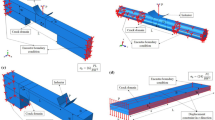Abstract
Two possible methods of including the effect of constraint in a failure assessment diagram (FAD) of the R6 type are to change the definition of the quantity Kr(the ratio of the operative crack driving force to the current material toughness) or to modify the failure assessment line (FAL). An analysis of the relation between the treatment of ductile tearing using the FAD and the R-curve diagram, extended recently to include constraint effects in modified diagrams of the first type is shown here also to hold for the second. Provided that the projected growth path image (PGPI) is used to specify the motion of the assessment point during crack growth there is a complete correspondence of R-curve analysis with either type of FAD. The two methods, both formulated for any number of generic constraint parameters, are compared using a simple illustrative example in which the constraint is parametrized by T. The methods previously discussed for testing the consistency or conservatism of an engineering FAD can be extended to both types of generalized diagram which allow for crack tip constraint.
Similar content being viewed by others
References
B.A. Bilby, I.C. Howard and Z.H. Li, Proceedings of the Royal Society (London), A 444 (1994) 461–482.
B.A. Bilby, I.C. Howard and Z.H. Li, Proceddings of the Royal Society (London), A 444 (1994) 483–496.
B.A. Bilby, I.C. Howard and Z.H. Li, Proceedings of the Royal Society (London), A 444 (1994) 497–508.
Nuclear Electric Plc., Assessment of the Integrity of Structures Containing Defects. R/H/R6-Revision 3, Nuclear Electric Plc., UK (1992).
I. Milne, R.A. Ainsworth, A.R. Dowling and A.T. Stewart, Assessment of the Integrity of Structures Containing Defects. CEGB Report R/H/R6-Revision 3 (1986).
I. Milne, R.A. Ainsworth, A.R. Dowling and A.T. Stewart, Background to and Validation of CEGB Report R/H/R6-Revision 3. CEGB Report, R/H/R6-Revision 3, Validation (1987).
I. Milne, R.A. Ainsworth, A.R. Dowling and A.T. Stewart, International Journal of Pressure Vessels and Piping 32 (1988) 2–104.
I. Milne, R.A. Ainsworth, A.R. Dowling and A.T. Stewart, International Journal of Pressure Vessels and Piping 32 (1988) 105–196.
British Standards Institution, PD6493. Guidance on methods for assessing the acceptability level of flaws in fusion welded structures. Published Document, Second Edition August 1991. London: British Standards Institution (1991).
R.A. Ainsworth, International Journal of Pressure Vessels and Piping 64 (1955) 277–285.
I. MacLennan and J.W. Hancock, International Journal of Pressure Vessels and Piping 64 (1955) 287–298.
B.A. Bilby, I.C. Howard and Z.H. Li, Proceedings of the Royal Society (London) A 448 (1995) 281–291.
S.G. Larsson and A.J. Carlsson, Journal of Mechanics and Physics in Solids 21 (1973) 263–277.
B.A. Bilby, G.E. Cardew, M.R. Goldthorpe and I.C. Howard, Proceedings of a Seminar held at RAE Farnborough, London: The Institution of Mechanical Engineers Nov. 1986 (1986) 37–46.
B.A. Bilby, G.E. Cardew, M.R. Goldthorpe and I.C. Howard, Fifth report on the stability of cracks in tough materials to the Nuclear Installation Inspectorate of the Health and Safety Executive. A Finite Element Investigation of the effect of specimen geometry on crack tip fields in hardening materials. Department of Mechanical Engineering Report, University of Sheffield, U.K. (1987).
J.W. Hancock, W.G. Reuter and D.M. Parks, In Constraint Effects in Fracture (eds. E.M. Hackett, K.H. Schwalbe and R.H. Dodds), Symposium on Constraint Effects in Fracture, Indianapolis, May 1991. American Society for Testing and Materials Special Technical Publication Vol. 1171 (1993) CH.23 21–40
G. Harlin and J.R. Willis, Proceedings of the Royal Society (London) A 415 (1988) 197–226.
B.A. Bilby, Fundamentals of ductile fracture. In: Defect Assessment in Components-Fundamentals and Applications. European Symposium on Elastic Plastic Fracture Mechanics, Freiburg, 9–12 October 1989. ESIS/EGF Publication 9. (ed. J.G. Blauel and K.H. Schwalbe), London: Mechanical Engineering Publications Limited (1991) 3–18.
D.M. Parks, Three dimensional aspects of HRR dominance. In: Defect Assessment in Components-Fundamentals and Applications. European Symposium on Elastic Plastic Fracture Mechanics, Freiburg, 9–12 October 1989. ESIS/EGF Publication 9. (ed. J.G. Blauel and K.H. Schwalbe), London: Mechanical Engineering Publications Limited (1991) 205–231.
N.P. O'Dowd and C.F. Shih, Journal of Mechanics and Physics in Solids 39 (1991) 989–1015.
N.P. O'Dowd and C.F. Shih, Journal of Mechanics and Physics in Solids 40 (1992) 939–963.
E. Roos, U. Eisele, H. Silcher and F. Spaeth, Nuclear Engineering Design 102 (1987) 439–449.
W. Brocks, G. Kunecke and K. Wobst, International Journal of Pressure Vessels and Piping 40 (1989) 77–90.
J.R. Gordon and S.J. Garwood, In: The assessment of cracked components by fracture mechanics 1989, EGF 4 (ed. L.H. Larsson), Mechanical Engineering Publications Limited, London (1989) 303–311.
J.R. Gordon and S.J. Garwood, In: The assessment of cracked components by fracture mechanics 1989, EGF 4 (ed. L.H. Larsson), Mechanical Engineering Publications Limited, London (1989) 473–493.
I. MacLennan and J.W. Hancock, Report of AEA Seminar, Risley, August (1993).
V. Kumar, M.D. German and F. Shih, An engineering approach for elastic plastic fracture, EPRI Report NP-1931. Palo Alto, California: Electric Power Research Institute (1981).
Y. Murakami, Stress Intensity Factors Handbook, Vol. I. Pergamon Press, Oxford (1987).
Author information
Authors and Affiliations
Rights and permissions
About this article
Cite this article
Bilby, B.A., Howard, I.C. & Li, Z.H. The use of constraint-modified failure assessment lines in failure assessment diagrams. Int J Fract 75, 323–334 (1996). https://doi.org/10.1007/BF00019612
Received:
Accepted:
Published:
Issue Date:
DOI: https://doi.org/10.1007/BF00019612




